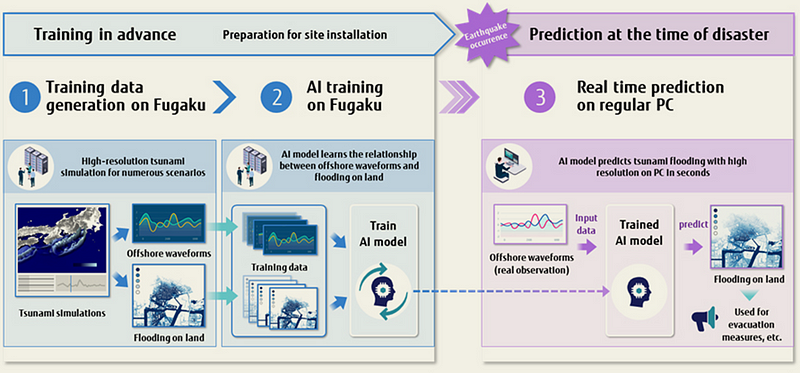Unleashing AI: The Tsunami Prediction Revolution
Written on
Chapter 1: The Rise of Fugaku
In the summer of last year, I discussed how Fugaku, Japan's computing powerhouse, outstripped the American supercomputer Summit to become the fastest in the world. Since then, Fugaku has not only retained its top position but has also expanded its capabilities. According to the 56th edition of the TOP500 list released in November 2020, its core count jumped from 7,299,072 to an impressive 7,630,848, achieving a staggering 442 petaflops in the High-Performance Linpack (HPL) benchmark. This extraordinary supercomputer, managed by the RIKEN Center for Computational Science and Fujitsu, is now utilized to craft a groundbreaking tsunami prediction tool.
As part of a collaborative international effort, the International Research Institute of Disaster Science at Tohoku University, the Earthquake Research Institute at the University of Tokyo, and Fujitsu Laboratories are creating an AI model capable of predicting tsunami flooding in coastal regions nearly in real-time. This innovative tool promises to be invaluable for disaster management teams, harnessing the immense computational power of the world’s fastest supercomputer.
Section 1.1: Lessons from Past Disasters
Japan experienced one of the most devastating tsunamis in modern history in 2011, following a 9.0-magnitude earthquake that generated a 33-foot (10 m) high tsunami along the northeastern coast. The calamity resulted in at least 18,550 confirmed deaths or missing persons, underscoring the critical need for timely information to facilitate safe evacuations during emergencies.
Following this tragic incident, the Japanese authorities significantly strengthened the tsunami observation network in coastal waters and prioritized the advancement of precise tsunami prediction technologies. These developments leverage real-time data from offshore tsunami observations, with AI models trained on simulated offshore waveforms and coastal flooding conditions.

Section 1.2: Moving Beyond Traditional Methods
Historically, tsunami predictions have relied on selecting data that mirrors earthquake and tsunami conditions from pre-prepared simulation databases. While these simulations typically utilize large-scale supercomputers, they face challenges when it comes to establishing a practical prediction system.
To tackle this issue, researchers employed a deep learning algorithm to analyze and validate the offshore tsunami waveform data in conjunction with the resulting land flooding conditions, gradually enhancing prediction accuracy. Utilizing advanced equipment, they created high-resolution tsunami simulations and trained the AI model on a dataset featuring 20,000 potential tsunami scenarios.
Chapter 2: The AI Model in Action
According to the press release, the deep learning tool comprises a two-stage AI configuration. Initially, it approximates land flooding situations in rough detail based on observed offshore tsunami waveforms. The AI then refines the flooding condition estimations, optimizing computation performance for learning within Fugaku.
The video titled "The Tsunami Has Arrived, The Tidal Impact of AI" delves into how AI technologies can transform tsunami predictions and enhance disaster preparedness.
The technology was successfully tested using a hypothetical massive Nankai Trough earthquake scenario, accurately predicting various tsunami scenarios within seconds on a standard PC, including the tsunami model. Notably, the AI’s predictions aligned closely with those of Japan's Cabinet Office.
Researchers aim to expand the AI model's training to encompass additional tsunami scenarios, enhancing its capacity to predict unexpected tsunamis and floods over broader regions. This ongoing refinement of prediction accuracy is crucial for facilitating the global application of these pioneering technologies.

Stay informed with the content that matters — Join my mailing list